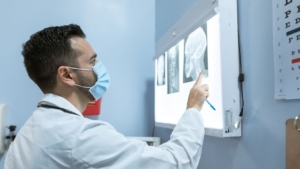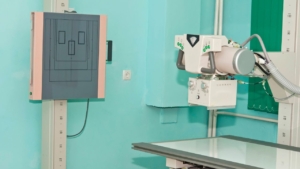Key Takeaways
- Digital Radiography Systems improve image quality and workflow efficiency, ensuring accurate diagnoses with reduced radiation exposure.
- Flat Panel Detectors enhance real-time imaging, offering superior contrast and faster image processing for better patient outcomes.
- MRI and CT scanners provide detailed internal imaging, aiding in the diagnosis of critical conditions with cutting-edge AI integration.
- Nuclear Medicine Equipment enables early disease detection by imaging functional processes, benefiting high-risk and asymptomatic patients.
- Enterprise Imaging Solutions streamline data access and enhance collaboration, ensuring secure and efficient patient data management across healthcare facilities.
Advanced diagnostic imaging is crucial for accurate medical assessments. Cutting-edge radiology imaging equipment ensures clear visuals, streamlined workflows, and improved patient care.
With rapid advancements in medical technology, healthcare providers must stay updated with the latest tools that enhance diagnostic capabilities. Investing in the right equipment not only improves efficiency but also leads to better patient outcomes. Here are eight must-have tools to enhance diagnostics and optimize radiology practices.
1. Digital Radiography Systems
Digital Radiography (DR) systems provide high-resolution X-ray images with reduced radiation exposure. These systems improve workflow efficiency and image quality, helping healthcare providers diagnose accurately. Unlike traditional film-based X-rays, DR systems allow instant image acquisition, minimizing wait times for both patients and radiologists.
They also integrate seamlessly with Picture Archiving and Communication Systems (PACS), ensuring smooth data management and retrieval. Spectrum Medical Imaging Co. offers top-tier digital imaging equipment tailored for various clinical scenarios, helping facilities enhance their diagnostic capabilities.
2. Flat Panel Detectors
Flat panel detectors (FPDs) are essential for capturing superior digital images. They enhance operational efficiency and enable real-time imaging for accurate clinical decisions. These detectors replace older analog systems, offering better contrast, reduced noise, and faster image processing.
Available in wired and wireless configurations, FPDs provide greater flexibility in positioning, making them ideal for a wide range of applications, including emergency rooms, operating theaters, and outpatient settings. By reducing radiation exposure while maintaining high image quality, they contribute to improved patient outcomes.
3. Magnetic Resonance Imaging (MRI) Machines
MRI machines provide detailed images of soft tissues, aiding in the diagnosis of conditions like myocardial infarction and systemic fibrosis. Unlike X-rays or CT scans, MRI uses powerful magnets and radio waves to generate highly detailed images without radiation exposure. This makes it the preferred imaging modality for evaluating the brain, spinal cord, joints, and abdominal organs.
Newer MRI systems incorporate machine learning capabilities to optimize image reconstruction, improving clarity and reducing scan times. These innovations benefit high-risk patients, including pediatric and asymptomatic patients, by providing safer, faster, and more accurate diagnostic results.
4. Computed Tomography (CT) Scanners
CT scanners deliver detailed cross-sectional images of the body, essential for detecting acute chest pain, abdominal pain, and pelvic pain. These advanced imaging tools use X-rays and sophisticated algorithms to produce 3D images of internal structures, aiding in early disease detection.
Modern CT scanners are equipped with artificial intelligence to enhance workflow efficiency and reduce unnecessary scans. Additionally, low-dose CT technology helps minimize radiation exposure while maintaining diagnostic accuracy. They are widely used in emergency and routine imaging, offering efficiency improvements for clinicians in fast-paced environments.
5. X-Ray Imaging Systems
X-ray imaging remains a preferred imaging modality for routine chest radiography and orthopedic assessments. It plays a crucial role in diagnosing fractures, lung infections, and joint conditions. Advanced digital detectors ensure quality images while adhering to American College of Radiology standards. Portable and mobile X-ray systems further enhance accessibility, especially in intensive care units and remote locations.
These systems support high patient throughput, reducing wait times and improving overall workflow in radiology departments. With recent advancements in digital X-ray technology, image clarity has significantly improved, ensuring more precise clinical decisions.
6. Nuclear Medicine Equipment
Nuclear medicine tools are critical for imaging functional processes within the body. Unlike traditional radiography, nuclear imaging focuses on physiological changes rather than anatomical structures. It assists in diagnosing diseases at an early stage, particularly in asymptomatic patients, by using small amounts of radioactive tracers. These tracers accumulate in specific organs, allowing physicians to assess conditions such as cancer, heart disease, and neurological disorders. United Imaging and Konica Minolta Healthcare provide innovative solutions in this field, ensuring accurate diagnoses and personalized treatment planning. The integration of deep learning in nuclear medicine further refines image interpretation and improves diagnostic accuracy.
7. Enterprise Imaging Solutions
Enterprise Imaging platforms streamline data sharing and storage, improving decision support tools for healthcare providers. These systems consolidate imaging data from various modalities into a centralized database, making it easily accessible across different departments. This enhances collaboration among radiologists, specialists, and referring physicians. By integrating with health IT tools, enterprise imaging solutions support better patient outcomes and enhance diagnostic imaging efficiency.
Advanced security protocols ensure compliance with the Health Insurance Portability and Accountability Act (HIPAA), protecting patient data while enabling seamless communication within healthcare networks.
8. Chiropractic Imaging Systems
Chiropractic care benefits from specialized imaging systems designed for spinal assessments. These systems provide high-resolution images of the musculoskeletal system, aiding in diagnosing conditions such as scoliosis, degenerative disc disease, and spinal misalignments. Digital radiography equipment in chiropractic imaging ensures precise measurements and better visualization of structural abnormalities.
Modern systems also incorporate software for motion analysis, helping practitioners develop personalized treatment plans. By utilizing advanced imaging solutions, chiropractors can improve patient care and enhance clinical outcomes with greater accuracy and efficiency.
Your Imaging Needs, Our Expertise
The field of radiology is constantly evolving, and having the right imaging equipment is crucial for delivering top-notch healthcare. Whether you are a hospital, a private clinic, or a specialized healthcare provider, investing in advanced diagnostic tools is essential for improved patient care and operational efficiency. Spectrum Medical Imaging Co. provides a wide range of medical imaging products and agents as a trusted distributor. With years of expertise in the industry, our team is committed to helping you find the right solutions tailored to your needs.
Our sales experts are ready to match you with the best solutions to enhance your radiology practice. Call us at 1-800-859-6162 to explore our offerings today and take the next step toward upgrading your imaging capabilities!




